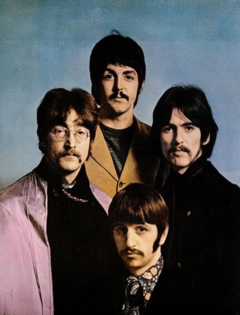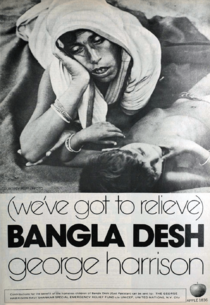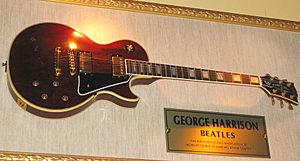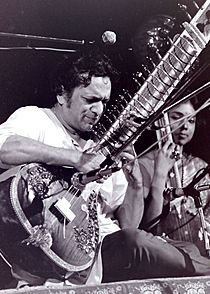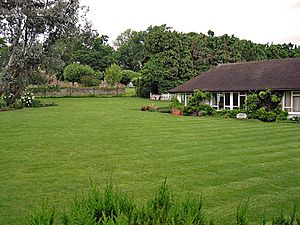George Harrison facts for kids
Quick facts for kids
George Harrison
|
|
|---|---|
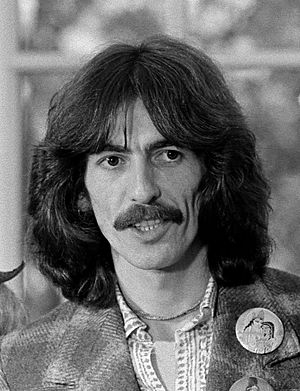
Harrison at the White House in 1974
|
|
| Born | 25 February 1943 Liverpool, England
|
| Died | 29 November 2001 (aged 58) Los Angeles, California, US
|
| Occupation |
|
| Years active | 1958–2001 |
| Spouse(s) |
|
| Children | Dhani |
| Musical career | |
| Genres | |
| Instruments |
|
| Labels |
|
| Signature | |
 |
|
George Harrison (born 25 February 1943 – died 29 November 2001) was an English musician. He became famous worldwide as the lead guitarist for the Beatles. People sometimes called him "the quiet Beatle".
George Harrison loved Indian culture. He helped make popular music more diverse. He did this by adding Indian instruments and Hindu spiritual ideas to the Beatles' songs. Even though John Lennon and Paul McCartney wrote most of the band's songs, George wrote at least two songs on most Beatles albums from 1965 onwards. Some of his famous songs for the group include "Taxman", "While My Guitar Gently Weeps", "Here Comes the Sun" and "Something".
Contents
- Early Life and Music Beginnings
- The Beatles: A Global Sensation
- Solo Career: Finding His Own Voice
- Later Career and Legacy
- Final Years and Passing
- His Music Style
- Film Production and HandMade Films
- Helping Others: Humanitarian Work
- Personal Life
- Legacy and Awards
- Discography
- Images for kids
- See also
Early Life and Music Beginnings
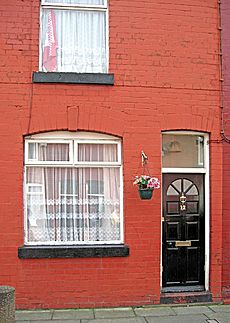
George Harrison was born on 25 February 1943 in Wavertree, Liverpool. He was the youngest of four children. His father, Harold, was a bus conductor. His mother, Louise, loved music. She often listened to Radio India when she was expecting George. She hoped the music would bring peace to her baby.
George lived in a small house with an outdoor toilet for his first four years. In 1949, his family moved to a new home. He started school at Dovedale Primary School at age five. Later, he went to Liverpool Institute High School. He was disappointed the school didn't teach guitar.
George's early music heroes included George Formby and Django Reinhardt. In 1956, he heard Elvis Presley's "Heartbreak Hotel". This song made him love rock and roll. He often drew guitars in his school books. He said, "I was totally into guitars."
His father was unsure about George's music dreams at first. But in 1956, he bought George an acoustic guitar. A friend taught George some songs. Inspired by Lonnie Donegan, George formed a skiffle group called the Rebels. He met Paul McCartney on the bus to school. They became friends because they both loved music.
The Beatles: A Global Sensation
Paul McCartney and his friend John Lennon were in a skiffle group called the Quarrymen. In 1958, George auditioned for them. He played "Guitar Boogie Shuffle". John Lennon thought George, who was just 15, was too young. Paul arranged another meeting. George impressed John by playing "Raunchy" on a bus. He soon became a member of the band.
George left school at 16. He worked as an electrician's helper for a few months. In 1960, the band, now called the Beatles, played in clubs in Hamburg, Germany. George was sent home because he was too young to work in nightclubs.
Brian Epstein became their manager in 1961. He helped them get a record deal with EMI. Their first single, "Love Me Do", was a hit. By 1963, when their first album Please Please Me came out, "Beatlemania" had begun. George was often serious on stage. This led to his nickname, "the quiet Beatle." This nickname stuck after he was advised to limit talking due to a fever during their first US tour.
George helped the Beatles find new American music. He loved soul music. By 1965, he introduced the band to folk rock and Indian classical music. He used a sitar on "Norwegian Wood (This Bird Has Flown)". He later called Rubber Soul his favorite Beatles album.
Their 1966 album Revolver had three of George's songs: "Taxman", "Love You To" and "I Want to Tell You". His sitar and tabla playing on "Love You To" was the Beatles' first real step into Indian music. This song helped show Asian culture respectfully in popular music. After "Norwegian Wood," George became known as "the maharaja of raga-rock."
By late 1966, George's interests grew beyond the Beatles. He included Eastern spiritual leaders on the cover of Sgt. Pepper's Lonely Hearts Club Band (1967). His only song on that album was "Within You Without You". He played sitar and tambura on it.
In 1968, George recorded "The Inner Light" in Mumbai, India. It was the first George Harrison song on a Beatles single. The lyrics showed his growing interest in Hinduism and meditation. During the recording of The Beatles (also known as the "White Album") that year, there were some arguments in the band. George's songs on the album included "While My Guitar Gently Weeps", which featured Eric Clapton on guitar.
George became good friends with Bob Dylan in 1968. He liked how Dylan's band, The Band, worked together as equals. This was different from how John and Paul often controlled the Beatles' songwriting. George started writing many more songs. He wanted to be more independent from the Beatles.
In January 1969, George briefly left the Beatles. He was frustrated with filming the Let It Be documentary. He also felt John and Paul were too controlling. He came back 12 days later after the band agreed to move the film project to their own studio.
Relations were better when the band recorded their 1969 album Abbey Road. George contributed "Here Comes the Sun" and "Something". These songs showed he was now an equal songwriter with John and Paul. "Something" became his first song released as an A-side single. It was number one in many countries. Frank Sinatra called it "the greatest love song of the past fifty years."
By the time the Beatles broke up, George had many unreleased songs. His limited space on Beatles albums added to his frustration. His last recording session with the Beatles was on 4 January 1970. They recorded his song "I Me Mine" for the Let It Be album.
Solo Career: Finding His Own Voice
Early Solo Work
Before the Beatles broke up, George released two solo albums. Wonderwall Music (1968) was a movie soundtrack. It mixed Indian and Western instruments. Electronic Sound (1969) was an experimental album using a Moog synthesizer. Wonderwall Music was the first solo album by any Beatle. It was also the first album released by Apple Records.
In late 1969, George toured Europe with Delaney & Bonnie and Friends. During this tour, he started playing slide guitar. He also began writing "My Sweet Lord". This song would become his first solo single.
All Things Must Pass: A Huge Success
For years, George couldn't put many of his songs on Beatles albums. So, he released All Things Must Pass in 1970. It was a triple album. Two discs had his songs, and the third had him jamming with friends. Many people thought it was his best work. It topped the music charts in both the US and UK.
The album included the number-one hit "My Sweet Lord". It also had the top-ten song "What Is Life". The album was co-produced by Phil Spector. It featured musicians like Ringo Starr, Eric Clapton, and Billy Preston. Critics loved All Things Must Pass. One reviewer called it "the music of mountain tops and vast horizons."
In 1971, George was sued over "My Sweet Lord." The song sounded similar to "He's So Fine" by The Chiffons. George lost the case. The judge said he had copied the song without realizing it.
In 2000, George helped promote a new version of the album. He said, "It was me sort of getting out of the Beatles and just going my own way."
The Concert for Bangladesh
In 1971, George helped his friend Ravi Shankar. Shankar asked for help for refugees in Bangladesh. George quickly organized the Concert for Bangladesh. It took place on 1 August 1971. Over 40,000 people came to two shows in New York City. The goal was to raise money for starving refugees during the Bangladesh Liberation War.
Many famous musicians played, including Bob Dylan, Eric Clapton, and Ringo Starr. A triple album and a concert film were released. The album topped the UK chart and won a Grammy Award. Some money was held up due to tax issues. But George said the main goal was to "attract attention to the situation." He felt they "spread the word and helped get the war ended."
Later Albums and Tours
George's 1973 album Living in the Material World was number one in the US for five weeks. Its single, "Give Me Love (Give Me Peace on Earth)", also hit number one. The album showed George's Hindu beliefs. Some critics loved it, calling it "miraculous in its radiance." Others found it too serious.
In 1974, George became the first ex-Beatle to tour North America. He played 45 shows. His band included Billy Preston and Tom Scott. Ravi Shankar also performed Indian music. The tour got mixed reviews. Some fans were disappointed by the Indian music. George's voice was also affected by laryngitis. Critics called it the "dark hoarse" tour. But some fans found it "uplifting" and "groundbreaking."
His album Dark Horse (1974) received his least positive reviews. Rolling Stone said it showed a performer "out of his element." The album reached number 4 in the US. His next album, Extra Texture (Read All About It) (1975), was inspired by soul music. George felt it was his least favorite album since All Things Must Pass.
In 1976, George released Thirty Three & 1/3. This was his first album on his own Dark Horse Records label. It had hit singles like "This Song" and "Crackerbox Palace". The album was praised for its melodies and musicianship. It sold well and George performed on Saturday Night Live with Paul Simon.
His 1979 album George Harrison came after his second marriage and the birth of his son, Dhani. The album and single "Blow Away" were top 20 hits. This album marked George's slow step back from the music business. Many songs were written in the peaceful setting of Maui.
Somewhere in England to Cloud Nine
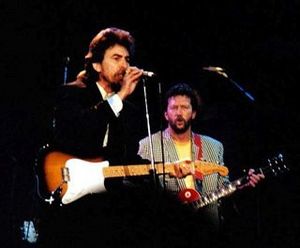
The murder of John Lennon in December 1980 deeply affected George. It made him worry about stalkers. He changed a song he had written for Ringo Starr into a tribute to John. "All Those Years Ago" featured Paul and Linda McCartney, and Ringo Starr. It reached number two in the US charts. This song was on his 1981 album Somewhere in England.
George didn't release new albums for five years after Gone Troppo (1982). During this time, he made guest appearances. He performed at a tribute to Carl Perkins in 1985. He also appeared at the Prince's Trust concert in 1987.
In November 1987, George released the successful album Cloud Nine. He co-produced it with Jeff Lynne. The album included his hit song "Got My Mind Set on You", which was number one in the US. The music video for "When We Was Fab" won two MTV awards. George's slide guitar playing was a big part of the album.
Later Career and Legacy
The Traveling Wilburys
In 1988, George formed the Traveling Wilburys with Jeff Lynne, Roy Orbison, Bob Dylan, and Tom Petty. They first gathered to record a song for a George Harrison single. But the song, "Handle with Care", was so good that his record company asked for a full album.
Their album, Traveling Wilburys Vol. 1, came out in October 1988. They used fake names, pretending to be half-brothers. The album was a big hit, selling millions of copies. After Roy Orbison's death, the remaining four members recorded a second album in 1990, titled Traveling Wilburys Vol. 3. The Wilburys never performed live.
In December 1991, George toured Japan with Eric Clapton. This was his first tour since 1974. He also performed at a Bob Dylan tribute concert in 1992.
The Beatles Anthology
In 1994, George worked with Paul McCartney, Ringo Starr, and producer Jeff Lynne on the Beatles Anthology project. They created two new Beatles songs. They used old vocal and piano recordings by John Lennon. "Free as a Bird" was released in December 1995. It was the first new Beatles single since 1970. A second single, "Real Love", followed in 1996. George later joked, "I hope somebody does this to all my demos when I'm dead."
Final Years and Passing
After the Anthology project, George worked with Ravi Shankar on his album Chants of India. In May 1997, George made his final TV appearance to promote this album. Soon after, he was diagnosed with throat cancer. He received treatment and publicly blamed years of smoking for the illness.
In 1999, George and his wife, Olivia, were attacked by an intruder at their home, Friar Park. George was stabbed but survived.
In May 2001, it was revealed that George had surgery for a cancerous growth in his lung. In July, he was treated for a brain tumor in Switzerland. Ringo Starr visited him there. In November 2001, he received more treatment in New York City.
George Harrison passed away on 29 November 2001, at age 58. He was with his wife Olivia, son Dhani, and close friends. His final message was: "Everything else can wait, but the search for God cannot wait, and love one another." His ashes were scattered in the Ganges and Yamuna rivers in India, following Hindu tradition. He left behind a large fortune.
George's final album, Brainwashed (2002), was released after his death. His son Dhani and Jeff Lynne finished it. The album included a quote from the Bhagavad Gita: "There never was a time when you or I did not exist. Nor will there be any future when we shall cease to be." The song "Marwa Blues" won a Grammy Award in 2004.
His Music Style
Guitar Playing
George Harrison's guitar playing with the Beatles was very flexible. He wasn't known for super-fast solos. Instead, his lead guitar was solid and melodic. He was also innovative with rhythm guitar. For example, he used a capo on acoustic guitars to create a bright sound. Eric Clapton called George "clearly an innovator."
George was influenced by country guitarists like Chet Atkins and Carl Perkins. This gave a country feel to some Beatles songs. He also looked up to Chuck Berry.
In 1964, George developed his own guitar style. He used a Rickenbacker 360/12 twelve-string electric guitar. This guitar created a "jangly" sound. It became known as the Beatles' "secret weapon." In 1965, he used an expression pedal to control his guitar's volume. This created unique effects on songs like "I Need You".
On Revolver (1966), George added many new ideas. He played backwards guitar on "I'm Only Sleeping". His guitar part on "Lucy in the Sky with Diamonds" mirrored John Lennon's singing. His solo on "Old Brown Shoe" was described as "sizzling."
His playing on Abbey Road, especially on "Something", was a big step. The solo on "Something" showed influences from blues and Indian music. It is considered a "masterpiece in simplicity."
After Delaney Bramlett taught him, George started playing slide guitar. This allowed him to sound like Indian instruments. His slide playing on John Lennon's "How Do You Sleep?" is famous. John Lennon said it was "the best he's ever played in his life."
George also loved the ukulele. He played a ukulele solo at the end of "Free as a Bird". He was a member of the Ukulele Society of Great Britain. He also played bass guitar on some Beatles songs.
Sitar and Indian Music
In 1965, George's friend David Crosby introduced him to Indian classical music. He heard the sitar maestro Ravi Shankar. George was fascinated. He called Shankar "the first person who ever impressed me." George became deeply interested in Indian music.
George's use of the sitar on "Norwegian Wood" opened the door for Indian instruments in rock music. Ravi Shankar called it "The Great Sitar Explosion." Many people credit George with this trend.
In June 1966, George met Shankar and became his student. He traveled to India to buy a sitar. In September, he went back to India to study sitar for six weeks. He stayed in Bombay and then a houseboat in Kashmir. He studied the instrument until 1968. He decided he wouldn't be a great sitar player because he started too late. But he continued to use Indian instruments in his solo work. He is known for bringing non-Western music to a wider audience.
Songwriting
George wrote his first song, "Don't Bother Me," in 1963. He said it was "an exercise to see if I could write a song." His songwriting got better over time. But John Lennon, Paul McCartney, and producer George Martin didn't fully appreciate his songs until later. In 1969, Paul told John that George's songs were "at least as good as ours."
George often had trouble getting the Beatles to record his songs. Most Beatles albums from 1965 onwards had at least two of his songs. Revolver had three, and it's seen as the album where George became a strong songwriter.
His interest in Indian music greatly influenced his songwriting. It helped him create new sounds for the Beatles. His use of unusual chords on songs like "Taxman" was groundbreaking in popular music.
The 1967 song "Within You Without You" mixed pop and Indian music. John Lennon called it one of George's best. George's song "The Inner Light" also showed his deep interest in Indian music.
"Something" from Abbey Road is considered a masterpiece. It's a romantic song that became one of the Beatles' most famous. Abbey Road was a turning point for George as a songwriter. His two songs on the album, "Here Comes the Sun" and "Something," are considered equal to any other Beatles songs.
Collaborations
From 1968 onwards, George worked with many other musicians. He invited Eric Clapton to play on "While My Guitar Gently Weeps." He also worked with John Barham on his solo album Wonderwall Music. He played on tracks for artists like Dave Mason, Billy Preston, and Ronnie Wood.
George co-wrote songs with Bob Dylan, Eric Clapton, and Tom Petty. He also produced albums for other artists on Apple Records. He co-wrote "Badge" with Eric Clapton for the band Cream. He played guitar on some songs for Bob Dylan's album New Morning in 1970.
Between 1971 and 1973, he co-wrote and produced three hit songs for Ringo Starr. He also played slide guitar on Badfinger's hit "Day After Day".
In 1974, George started his own record label, Dark Horse Records. He wanted it to be a place for other artists to be creative. The first artists on his label were Ravi Shankar and the duo Splinter. George produced their albums and played on them.
He continued to collaborate throughout his life. In 1996, he recorded "Distance Makes No Difference With Love" with Carl Perkins. In 2001, he played on Jeff Lynne's album Zoom. He also co-wrote a new song with his son Dhani, "Horse to the Water", just before he passed away.
Guitars
When George joined the Quarrymen in 1958, he played a Höfner President Acoustic guitar. His first electric guitar was a Jolana Futurama. For early Beatles recordings, he mainly used Gretsch guitars. These included a Gretsch Duo Jet and a Gretsch Country Gentleman.
In 1963, he bought a Rickenbacker 425. In 1964, he got a Rickenbacker 360/12, which was only the second one ever made. He got his first Fender Stratocaster in 1965. He used it on the Help! and Rubber Soul albums.
In 1966, George and John Lennon each bought Epiphone Casino guitars. George also used a Gibson J-160E and a Gibson SG Standard. In 1968, Eric Clapton gave him a Gibson Les Paul that George nicknamed "Lucy". Fender also gave him a custom-made Fender Telecaster Rosewood guitar.
Film Production and HandMade Films
George helped fund Ravi Shankar's documentary Raga in 1971. He also produced the Concert for Bangladesh film.
In 1978, George and his business partner Denis O'Brien formed HandMade Films. They created the company to produce Monty Python's Life of Brian. Another company had pulled its funding. George helped finance the film by mortgaging his home. The film made $21 million in the US.
HandMade Films produced many memorable movies in the 1980s. These included Time Bandits (1981), Mona Lisa (1986), and Withnail and I (1987). George even made small appearances in some films, like Shanghai Surprise. His work with HandMade Films helped British cinema during a difficult time.
However, HandMade Films faced financial problems in the late 1980s. George later sued his partner Denis O'Brien for fraud. The company stopped operations in 1991.
Helping Others: Humanitarian Work

George Harrison was involved in helping people throughout his life. In the 1960s, the Beatles supported the civil rights movement and protested the Vietnam War.
In 1971, Ravi Shankar asked George for help for the people of Bangladesh. They were suffering from a cyclone and war. George quickly wrote and recorded "Bangla Desh". It was one of the first charity singles in pop music. He then organized the Concert for Bangladesh. This event raised over $240,000. The album and film raised about $13.5 million. Even though there were some money problems, George said the main goal was to "spread the word" and help end the war.
From 1980, George supported groups like Greenpeace. He also protested against nuclear energy. In 1990, he helped his wife Olivia's Romanian Angel Appeal. This charity helped thousands of Romanian orphans. George recorded a song with the Traveling Wilburys, "Nobody's Child", to raise money.
The Concert for Bangladesh was a model for later large charity concerts like Live Aid. Today, the George Harrison Humanitarian Fund for UNICEF helps children in emergencies. In 2009, Ravi Shankar received the first George Harrison Humanitarian Award.
Personal Life
Hinduism and Spirituality
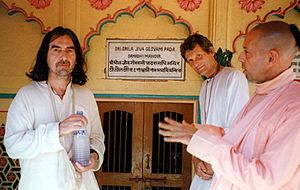
By the mid-1960s, George became very interested in Indian culture and spirituality. He introduced these ideas to the other Beatles. In 1966, he went to India with his first wife, Pattie Boyd. He studied sitar with Ravi Shankar and met spiritual teachers. In 1968, he traveled with the Beatles to India to study meditation.
George became a vegetarian in the late 1960s. He was a lifelong follower of the teachings of Swami Vivekananda and Paramahansa Yogananda. In 1969, he produced the single "Hare Krishna Mantra". He also helped the Radha Krishna Temple get started in Britain. He met their leader, A.C. Bhaktivedanta Swami Prabhupada. George called him "my master."
George embraced the Hare Krishna tradition. He especially loved chanting with beads. In 1972, he gave his mansion north of London to the devotees. It became a temple called Bhaktivedanta Manor. George believed that "All religions are branches of one big tree. It doesn't matter what you call Him just as long as you call."
Family and Hobbies
George married model Pattie Boyd on 21 January 1966. They met in 1964 while filming A Hard Day's Night. George playfully proposed to her during lunch. They separated in 1974 and divorced in 1977.
On 2 September 1978, George married Olivia Trinidad Arias. She worked for his record label. They had one son, Dhani Harrison, born on 1 August 1978.
George restored his English manor house, Friar Park, in Henley-on-Thames. He filmed several music videos there. He loved gardening. He said, "Sometimes I feel like I'm actually on the wrong planet, and it's great when I'm in my garden." His autobiography, I, Me, Mine, is dedicated "to gardeners everywhere."
George also loved sports cars and motor racing. He collected photos of racing drivers. He wrote the song "Faster" as a tribute to Formula One drivers.
Relationships with the Other Beatles
For most of the Beatles' time together, the band members were very close. They were each other's best friends. George's ex-wife Pattie Boyd said, "The Beatles all belonged to each other." Ringo Starr said, "We really looked out for each other and we had so many laughs together."
John Lennon said George was like a "young follower" when they started. Later, their paths changed. George found God, while John believed people create their own lives. In 1974, George said, "John Lennon is a saint and he's heavy-duty, and he's great and I love him."
George and Paul McCartney met first, on a school bus. They often learned guitar chords together. Paul called George his "baby brother." Their relationship could be difficult at times. But George said, "whatever we've been through, there's always been something that's tied us together."
Legacy and Awards
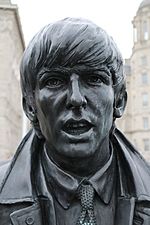
In June 1965, George and the other Beatles were made Members of the Order of the British Empire (MBE). They received their awards from the Queen. In 1971, the Beatles won an Academy Award for the music in their film Let It Be.
A small planet discovered in 1984 was named 4149 Harrison after him. In 1992, he received the Billboard Century Award. This award recognized his important work in music. It also praised his role in creating "world music" and showing the "spiritual power of popular music." Rolling Stone magazine ranked him number 11 on their list of the "100 Greatest Guitarists of All Time."
In 2002, a year after his death, the Concert for George was held. Eric Clapton organized the event. Many of George's friends and fellow musicians performed, including Paul McCartney and Ringo Starr. The money from the concert went to George's charity.
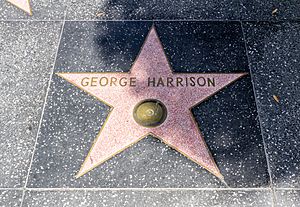
In 2004, George was added to the Rock and Roll Hall of Fame as a solo artist. In 2009, he received a star on the Hollywood Walk of Fame. Paul McCartney, Jeff Lynne, and Tom Petty were there for the ceremony. George's widow Olivia and son Dhani also spoke.
A documentary film about him, George Harrison: Living in the Material World, was released in 2011. It was directed by Martin Scorsese. In 2015, George was honored with a Grammy Lifetime Achievement Award.
Discography
- Wonderwall Music (1968)
- Electronic Sound (1969)
- All Things Must Pass (1970)
- Living in the Material World (1973)
- Dark Horse (1974)
- Extra Texture (Read All About It) (1975)
- Thirty Three & 1/3 (1976)
- George Harrison (1979)
- Somewhere in England (1981)
- Gone Troppo (1982)
- Cloud Nine (1987)
- Brainwashed (2002)
Images for kids
-
Harrison (left) and Ringo Starr (right) performing at the King's Hall in Belfast, 1964
See also
 In Spanish: George Harrison para niños
In Spanish: George Harrison para niños
- List of peace activists


